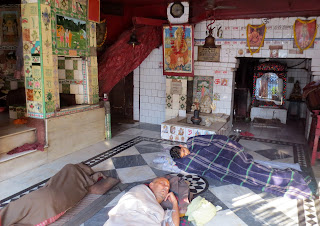 |
| Sanctuary (on stone wheels) to left. Building on right was a platform for dance, once roofed. |
My final day before starting the trek home. Breakfast late, write yesterday's blog post, check out the little shops down the road and wander on the beach. The hotel manager gives me a complimentary ticket for the first night of the annual Konark Dance Festival, so I book an auto rickshaw for 1.30 to get me there with plenty of time to see the celebrated Sun Temple. It's surprising how long it takes to cover 35 kms., even in a shiny new yellow tuk-tuk, but the road is smooth, following the coastline through a wildlife park ("Deers may cross") and on bridges over a series of pristine estuaries. It reminds me of a well-loved road in Tanzania, lush with tall palms, banana groves and villages with palm thatched mud brick homes.
The Sun Temple is a UNESCO World Heritage Site, voted one of the Seven Wonders of India in a TV poll (!). It's Saturday, and the heritage lovers are out in force, as busy as a stately home on an Antiques Roadshow day. Inevitably I get roped into several family photos but have stopped reciprocating - my computer has a strict limit on the number of images it can store of me with mama, mama-in-law, baba, babu, uncleji, auntiji and precocious little brats-ji. But I guess I look a bit of a buffoon as I wear my check shorts to feel the breeze on my knobbly knees in the tuk-tuk.
 |
| Note giraffe, far right. They must have traded with Africa. |
The temple all but defies description. It was conceived by the Eastern Ganga King in about 1250 as a thank offering to Suriya the Sun God who cured him of leprosy. Sadly, it was sacked by Muslims in the 1550s, then buried under mounds of blown sand awaiting rediscovery in 1902. But what remains is spectacular - a 200 ft. central shrine in the form of a giant carriage drawn by stone horses (now lost). The 24 huge stone wheels and axles remain, each serving as a sophisticated sundial at different times of the day and year. The real genius of the place is in its carvings. Every square inch is covered with delicate carvings ranging in size from miniature to massive. These depict hunting scenes, animals - literally thousands of elephants process round the base, scenes of domestic life, gods and mythological beasts. But mainly human forms - musicians, dancers, lovers - which are at the same time both delicate and decidedly indelicate. The celebrated scenes of eye-popping erotica are surely the largest collection anywhere of medieval stone porn, no holes barred. Look at the next post - if you dare! Rabindranath Tagore, the great Bengali writer, said something like "when words fail, the poetry of stone takes over". One theory is that the monument respresents a state of ultimate bliss - witness the rapture the faces of the less worn figures!
For such an ace place, it's disappointing that no guidebook is available (should I offer my services?), though before entering I am hassled by "government approved" guides offering to show me round, which I resist. Despite the crush of visitors, the site is immaculately kept (no litter) and is devoid of the usual plethora of notices, though I rather like "Do not ascend the embankment" on a grassy slope. Shades of "No picnicking on the greensward" at Frinton-on Sea.

From the temple I amble, Calcutta-style, towards the open-air arena erected for the Konark Dance Festival. I stop at a dhaba en route for a meal of onion bahjies, delicious round doughy things and a couple of sauces, all prepared in a giant wok over a blazing wood fire. Cost र40 (45p). I'm often surprised how rarely local people try to overcharge when they could so easily get away with it. That is the privilege of taxi drivers. The trees along the road to the festival are hung with fairy lights and hundreds of ornate Chinese lanterns, and expectancy is in the air. I show my (free) ticket and go in the V I P entrance but nobody cares, though I later notice that there is also a "V V I P Entrance". I don my long trousers, but feel distictly underdressed in the presence of so many immaculately turned-out Indian dance-lovers.
I have never before seen classical Indian dance, and do not fully understand the gestures and postures. The costumes are very like the 13th. century figures at the temple - the ones who haven't got there kit off, that is - and the movements are graceful and highly stylised, danced to complex twangy music performed live on stage. There are two groups of professional dancers and - nice touch, this - an artist has set up an easel at the side of the stage and works on a painting during the performance. For me, the crowning magnificence is the great floodlit temple in the background, its layers enhanced by light and shadow so it looks like a giant dalek radiating light against the black sky. There are, I estimate, about 2000 people present - not bad for a "high art" show in a one horse town beside the seaside.
I omitted to bring any warm clothing with me and it is decidedly cold on the way back in the rickshaw. I thread my arms through the legs of my check shorts and wear my (dry) bathing shorts on my head so I look like a Howrah Station porter.










